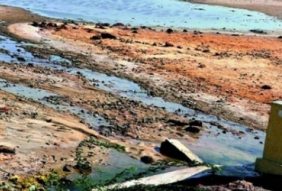
Posted on May 9, 2016
The Pulicat Lake, which is located both in Nellore district, AP, and Tiruvallur district, Tamil Nadu, has dried up totally on its northern side in AP, depriving many thousand people of a livelihood.
About 40,000 people, living in 34 villages on the banks of the lake on the Tamil Nadu side, and 25,000 people, living in 15 habitations in AP, depend directly or indirectly on the lake.
The 481 sq km lake, the second largest brackish-water ecosystem in India after Chilka in Odisha, is home to 160 different fish species and more than 110 varieties of terrestrial and aquatic birds and small mammals and reptiles. More than 60,000 migrant water birds, including flamingos, visit the northern part of the lake in winter.
The lake’s mouth, a major determining factor for the hydrology, biodiversity and fish in the lake, tends to get narrower and shallower during the post-monsoon months (January to September), chiefly due to the accretion of sand, resulting in the formation of a sand-bar across the lake’s mouth.
Fishermen on the Tamil Nadu side make it a point to clear the sand bars for easy access to their hamlets that are located close to Pulicat Lake. The lake has been drying up annually due to the closure of the mouths of the sea on the northern (AP) side at Kondurupalem and Rayadoruvu in Vakadu mandal of Nellore district several years ago.
AP leaders’ plentiful assurances to take up dredging operations to open the mouths of the sea remain on paper. Studies indicate that the average depth of the lake came down to 1.5 m from 4 m in many places, with its area reduced to 350 sq km in a few decades, which will, in turn, lead to a huge reduction in the aquatic population.
This is attributed to a rapid shrinking of the water spread area, mainly due to silting in the lake’s northern side. In fact, the lake was full to its brim even on the northern side because of heavy rains in November last year and December, but then it was dry by the end of January this year.
Sullurpeta Wildlife Division Forest Officer Dr B. Chandrasekhar pointed out that all the water emptied into the sea as the lake was on higher ground. He said that there was an urgent need to take up a survey of the levels before opening the sea’s mouth at Rayadoruvu and Kondurupalem.
A cost estimate, readied five years ago, had arrived at a sum of Rs 7 crore to carry out dredging operations. It would cost almost double that amount to take up desilting operations now, he added.
Source: Deccan Chronicle





